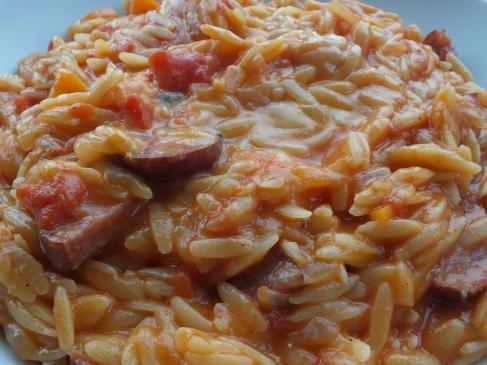The other day I went to do my much needed grocery shopping and saw that they had turkey leg packs (thigh and drumstick) on offer; £3 for 1.6Kg of turkey goodness. I went ahead and bought a pack, since I like turkey (if done properly and not turned into rubber). Anyway, I bought quite a few stuff I’m probably never going to use and started wondering what to do with my newly acquired bird parts. That thigh was HUGE!
When I see good but cheap ingredients I think about the good old comfort food and family style dinners. Being out of my mind, the first thing that I thought of was turkey lasagne! Making lasagne implied that I’d need to do some butchering (skinning, de-boning and mincing), which I find disturbingly therapeutic. For most applications I prefer making my own minced meat in the food processor, since it is easy and most importantly you know what goes in it! (Plus it’s an excuse to play with my kitchen gadgets 😀 ). Another good thing about lasagne is that you can spike them with veggies; kids won’t even know they’re there!! Personally, I don’t care about that; I just had some carrots and celery that I need to get rid of soon. Also, I love smoked turkey, but for some reason it is near impossible to find in the UK, so I decided to give that feel to my lasagne by adding some spicy smoked chorizo. Italians are probably going to have a heart attack when they see me using a spanish sausage in lasagne; I don’t care, I like it, it works so I use it! 😀
You didn’t think that I wouldn’t talk about science, did you? Most people associate turkey as being tough and dry. That’s partly true, if you don’t cook it properly. Meat is basically protein fibres (muscle), fat and water. The protein is what holds the meat together and used to do all the work when the animal was alive, hence it is strong stuff by nature, which is what you percieve as tough. When people say that their turkey turns out dry is basically because it was not cooked properly. Dry meat is because of too much moisture and water loss during the cooking process.Turkey is extremely lean, so the only thing that prevents it from being dry is the water trapped in the protein fibres. If you heat these fibres too aggressively they contract, denature, squeezing out all the water and toughening up. There are three basic approaches to solve this:
- The low and slow method. This way you gently heat the proteins to the point that the proteins start breaking down into other compounds that are both tastier and softer.
- Brining. If you submerge any meat in a salt-water solution you force moisture into the meat via osmosis and the protein structure is altered, making the meat hold onto moisture better. Brining and then cooking low and slow will give you the juiciest meat.
- Cut the fibres so you don’t have to bite into them! That’s the technique I’m using for the lasagne. Mincing the meat will ensure that there are no long muscle fibres to bite into, therefore making the meat tender.
Science is over. It’s recipe time!
Veggie-spiked turkey lasagne
Ingredients
For the cheese sauce:
- 3 tbsp olive oil
- 3 tbsp plain flour
- 650g hot milk
- 1 mozzarella ball
- 1/4 tsp freshly ground nutmeg
- salt,pepper
For the turkey ragù:
- 1 large onion
- 1 celery stalk
- 1 carrot
- 1 clove garlic
- 10-15 cm piece of chorizo (diced)
- 1/2 tsp cinnamon
- 1/2 tsp paprika
- 1 bay leaf
- 1/2 tsp oregano
- 400g tinned chopped tomatoes
- 800g turkey mince
- optional: the skin from the turkey
- 100ml white wine
Pasta:
- lasagne (about 250g should do; this depends on your pan, number of layers etc.)
Execution:
- Turn the oven on at 180C and start with the ragù. Put the chorizo (and turkey skin in a dry cold pan) and turn it on to medium.
- Meanwhile, roughly chop all your veggies (onion, garlic, celery, carrot) and put them in a food processor. Pulse until finely chopped (or if you have to do with picky eaters blitz it until it turns into a sludge – no veggie evidence for kids to fuss about).
- When the chorizo starts getting some colour get rid of the turkey skin and dump in the pan the contents of the food processor and the bay leaf. Sauté for 5 minutes, or until most of the moisture has evaporated.
- Add the turkey mince and stir around until the meat looks cooked.
- Add the rest of the ragù ingredients to the pot and let it simmer for about 30 minutes; this should be enough time for the cheese sauce.
- For the cheese sauce start with a roux; put the olive oil and the flour in a pot and whisk/stir around on a medium-low heat for 5 minutes, or until the mixture just barely starts to darken.
- Stirring continuously, add the milk, making sure to only add tiny amounts at the beginning otherwise you risk getting lumps. Once all the milk is in the pot keep stirring until it thickens.
- When thickened, turn the heat off, tear the mozzarella in and add the nutmeg and seasoning. Stir until the mozzarella has completely dissolved.
- Assembly time: put a small amount of the ragù (about 1/4) to the bottom of a pan and lay over the lasagne pasta sheets; you don’t need to cover the bottom, you just need a bed for the pasta. Lay 1/2 of the remaining ragù over the pasta, cover with pasta, add the rest of the ragù and add the last layer of pasta. Make sure to dump in the pan all the cooking juices. Finish the assembly by covering the top pasta layer with the cheese sauce.
- Bake for about 45 minutes, or until you get the brown patches you see in the picture all over the top of the lasagne.

Tips
- Cooked lasagne freeze really well and they are one of the foods that taste better the next day. I recommend you make a big batch, portion it and freeze for a quick microwave meal; if you don’t have a microwave just defrost and bake until warm through.
- Different vegetables will also work; ie. peppers, aubergine, courgettes etc.
- You may have noticed that there is no added oil in the ragù. This is because the chorizo is quite fatty and we rendered some of its fat out. If things start to stick to the bottom of the pan, or decide for some twisted reason to skip the chorizo just add some oil.










